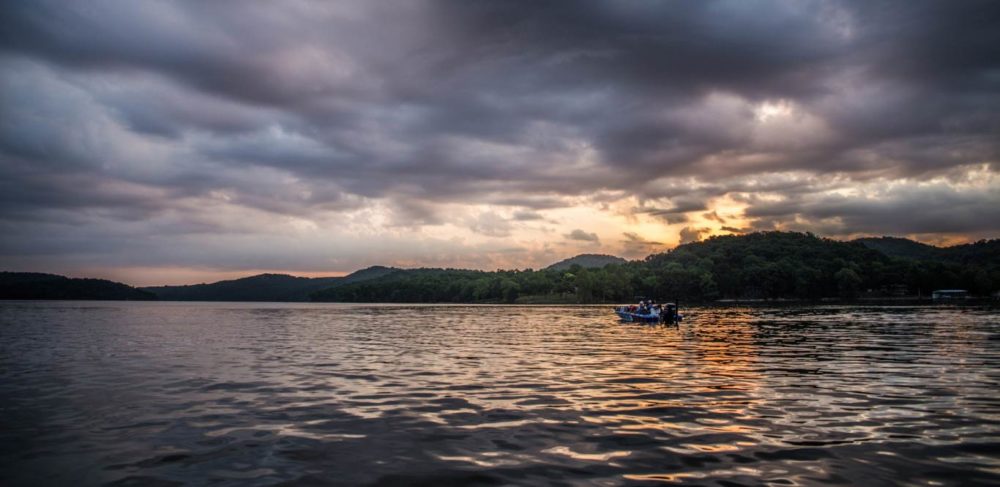PREVIEW: Best Laid Plans of the Summit Select Meet Rain in Qualifying Round 3

Just before the start of Qualifying Round 3 of the Major League Fishing Bass Pro Shops Summit Select presented by Ferguson on Lake of the Ozarks, MLF newbie Russ Lane of Prattville, Ala., sat in the parking lot of the Pa He Tsi boat ramp scrolling through his GPS mapping, taking a closer look at the day’s official zone in the Grand Glaize Arm, a repeat of Qualifying Round 1. As he zipped his cursor across the contour lines, he would occasionally drop waypoints on specific spots he wanted to investigate once his fishing day began.
“There’s one,” Lane said, as he mashed the waypoint button and the unit responded with a beep. “See how that point kind of flattens out right there before breaking off into deep water? I’ve never fished this lake before, but those are the kind of places that hold fish in June.”
Lane already had a firm plan in his mind.
“I don’t care if it takes me all of the first period to find a school,” he stated emphatically. “I’m not making a cast until I graph a wad of fish out offshore.”
Indeed, such a well-laid plan sounds bold, but rarely works in the MLF format.
MLF Select pro Mark Rose knows all too well how the high-risk offshore search for a “mother lode” goes in the MLF format.
“Trust me, it usually does not pan out very well,” said Rose, who is highly regarded as one of the best offshore structure fishermen on tour.
“I’ve tried it several times in this format,” Rose recalled. “You say to yourself you’re going to stick to it no matter what, but when that Scoretracker starts lighting up, it does something to you. It rushes you; it pushes you. You’re out there idling around without a bait in the water and the whole time your official is saying, ‘This guy just caught another bass. And that guy just caught another bass.’ I’m telling you it messes with your head and staying committed to the graphing game when that’s happening is really, really hard to do.”
Rose’s plan for the morning was to graph offshore during the ride through period. But if he did not see anything promising on his electronics, he would hit the bank for the official “lines in” call. “I’ve spent time graphing during the first period and I just got behind too far too fast because guys on the bank catch four or five up shallow in the first 30 minutes,” Rose said. “I know it’s June; I know the water is warm; I know fish should be offshore, but it takes a lot of time to find good offshore spots on an unfamiliar lake – sometimes days. The chances of finding something like that in an hour are just really slim.”
Further down the line of MLF boats, Brandon Palaniuk of Hayden, Idaho, was studying his map diligently. Palaniuk has never visited Lake of the Ozarks before and was busy scouring his map for any scrap of information he could glean.
Interestingly, Palaniuk didn’t seem to care as much about contours under the water as he did about paved roads up on dry land.
“I’m looking for any network of roads coming down to the lake,” Palaniuk said. “See these roads that come down along the lake and then loop back around – that’s what I’m interested in.” Palaniuk says a multitude of roads along a lakeshore usually means residential houses on the lake, and that means docks – and lots of them.
“It looks like we’re putting in here at the State Park,” said Palaniuk. “Since there are not many roads around these coves, here I’m guessing all these banks are all undeveloped. But farther up towards this bridge (Hwy 54) there are a lot of roads along the lake. I’m betting these coves in here are loaded with docks.”
Palaniuk believes populations of bass that live along natural, undeveloped banks often have different feeding habits than those that live in coves lined with docks. “I’m not saying one is better than the other, it just all depends on your fishing style and it gives you options to try,” Palaniuk added.
Another interesting point Palaniuk brought up is that having more options in a zone makes a zone “feel” bigger.
“You can have a zone that’s 10 miles long, but if it’s all just flat mud banks with a few hard points sticking out, it can become a small zone really fast,” he detailed. “And the converse is true: you can have a zone that’s only 3 or 4 miles long but if it’s loaded with docks, bridges, rip rap, roadbeds, laydowns, vegetation, etc, it can really make that zone feel big because of all the options. And it looks like we have a lot of options here; this zone looks big to me.”
Just then, Palaniuk’s map began to collect a few rain drops.
“Nothing like a little shower to start your day.” Palaniuk announced. “Time to go to work!”
With that, the MLF boats began to slide off into an overcast Lake of the Ozarks for the start of day three.